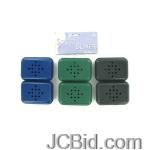
| Updated Blogs |
|
More .....
|
 RSS Feed | Login
RSS Feed | Login http://www.fr-batterie-portable.com
http://www.fr-batterie-portable.com/dell.html
Battery for Lenovo FRU 42T4783
By Zdziarski at 2017-06-28 23:25:18
Next, by writing sequences of '0' and '1', we're told you can create a carrier wave from the rapid voltage changes on the interface's data pins. You can then use binary frequency shift keying (B-FSK) to encode useful information into the wave.Guri reckons you can beam 80 bytes per second over the air using this technique, which is fast enough to send a 4,096-bit crypto key to a nearby receiver in less than 10 seconds.You then write the resulting buffer to, say, a mounted removable storage device to generate the signal. You don't need to be root or an administrator to do this; you just need permission to write to a file on the device."The actual data transmission is done by writing the byte pattern generated by fill_buffer_freq() to an arbitrary data block or stream in the USB device," Guri and his team said in a research paper that surfaced this week."The transmission process doesn't require special privileges (e.g., root or admin). It only requires permission to create a file on the removable device."In a video the team showed how the data can be picked up by a laptop with a $30 radio antenna from around 15 feet away. That's certainly enough to spy on someone working in the next hotel room, or in a crowded office.
It's an interesting hack, and one that could have some utility. Of course, to pull this off, you first have to get malware onto the air-gapped computer that then writes to a USB device, and you have to be nearby to pick up the signal – and hope no one notices. That's not outside the realms of possibility if you grease the right palms, threaten the right people, or exploit OPSEC screw-ups to get your espionage code onto the target machine. Obituary The creator of the world's first laptop, the GRiD Compass, has died at the age of 75 at his home in California.John Ellenby was born in the North of England in 1941 and educated at University College London, where he showed an early interest in computers. After a career designing mainframes he moved to the US, where he ended up joining the Xerox PARC brains trust that gave the world the PC, the graphical user interface (GUI), laser printing and the Ethernet.Ellenby was one of the team working on the Alto personal computer – which inspired Steve Jobs to rework Apple around the GUI – and also worked on the Alto II, which was a PC designed to be much cheaper to manufacture. While at PARC, he also worked on portable computers but had the idea for a clamshell laptop that would replace the portable model.
- Battery for Toshiba PA3730U-1BAS
- Battery for Toshiba PA3817U-1BRS
- Battery for Toshiba Qosmio X500
- Battery for Toshiba Satellite P505
- Battery for Toshiba Satellite Pro L670
- Battery for Lenovo G770
- Battery for lenovo G560
He and some PARC friends left the company in 1979 to set up GRiD Systems Corporation. The company initially designed portable computers but saw little success, thanks to competing companies like Osbourne and Compaq selling similar kit for less.But in 1985, the firm released the GRiD Compass 1101, an $8,150 laptop in a form factor that's now commonplace. The laptop ran an Intel 8086 processor, a 320×240-pixel electroluminescent display, had 340 kilobytes of magnetic bubble memory, and a 1,200 bit/s modem, all contained in a mag-alloy case.The Compass wasn't a perfect machine by any means. The power requirements were so high that the device had to be plugged in for use but, despite the high price, it was a hit among the well-heeled or government-funded buyer.Despite the high price, and the weight of the 5-kg (11-lb) machine, it sold very well in the military and government. NASA used the Compass as a backup computer for the space shuttle and one of the firm's laptops reportedly survived the 1986 Challenger disaster in working order.Hollywood also loved the futuristic look of the device – it was featured in numerous films, including the 1986 classic Aliens, where two Compass machines controlled the robotic sentry guns that briefly held off the savage beasts.Ellenby sold the company in 1988 to Tandy and started a portable tablet business, but never enjoyed the success he found with GRiD. He also founded GeoVector, an early pioneer in virtual reality systems.
He made his home in San Francisco and remained a tech tinkerer until his death earlier this month. He is survived by two sons and a grandchild. Intel's stop-gap Kaby Lake processors – aka the seventh-generation Core family – will ship in laptops starting from September, we're told.According to Chipzilla, the first wave of the new Cores will appear in 10mm-thick notebooks and two-in-one convertible tablets aimed at small businesses and normal folk. The CPUs will consume 4.5W to 15W, depending on the model, and go on sale in more than 100 laptop designs by the end-of-year shopping rush. They'll include Intel's usual integrated HD Graphics chipset.Come January, enterprise PCs, workstations and beefier notebooks and desktop systems will ship with the chips, some with Intel's Iris graphics chipset. Presumably that's when you'll be able to get your hands on individual processors to build you own rigs by hand.The processors are powered by the 14nm Kaby Lake microarchitecture. This is the Skylake microarchitecture – as used in 2015's 14nm sixth-generation Core family – with some tweaks and optimizations.Intel inserted Kaby Lake into its lineup after its tick-tock product cycle missed a beat. Usually, Intel shrinks a microarchitecture to a new process size and ships it (that's the tick), and later rolls out a new microarchitecture using that process size (that's the tock). There's a 12 to 18-month gap between the ticks and tocks.
- Battery for Lenovo FRU 42T4783
- Battery for Lenovo B460G
- Battery for Lenovo 57Y6455
- Battery for Lenovo 42T4901
- Battery for Dell Latitude D620
- Battery for Dell Inspiron N7010
- Battery for Dell Inspiron 9400
- Battery for Dell Inspiron 1721
- Battery for Dell Inspiron 1545
- Battery for Dell Inspiron 1525
- Battery for Dell Alienware M11x R3
The latest tock was the introduction of Skylake on 14nm. The next tick was going to be Cannonlake, aka Skylake on 10nm, but that was delayed to 2017 because Intel couldn't perfect the shrink in time. So in the meantime, we've been lumped with Kaby Lake, an optimized Skylake redux on 14nm. (Intel has now given up on the tick-tock approach, for what it's worth.)What do we mean by optimized? Well, for one thing, better physical manufacturing techniques. Intel says it has improved the fin design and the channel strain in its FinFETs. The shape of the fin has a massive effect on the operation of the transistor, potentially reducing the leakage current significantly. Increasing the strain in the channel increases performance and lowers power consumption by cutting the atomic forces that interfere with electron flow.
Intel's seventh-generation dual-core die with builtin GPU ... Click to enlarge any pics
According to Intel, these fabrication improvements from Skylake to Kaby Lake, plus some CPU enhancements, give seventh-generation Cores up to a 12 per cent performance boost over the sixth-generation – well, when running the SYSmark benchmark on a seventh-gen 15W 3.5GHz Core i7 7500U versus a sixth-gen 15W 3.1GHz Core i7 6500U. When running the WebXPRT benchmark on the same chips, the performance boost from Skylake to Kaby Lake can reach up to 19 per cent, we're told.
Generation debate ... How 2015 and 2016's Cores compare (Source: Intel)
So in other words, changing up from a 2015 Core i7 to the equivalent 2016 part can speed up web browsing by up to a fifth, in theory. Chipzilla also says its seventh-generation Cores are more power friendly when streaming vids: the new Core i7 7500U can play 4K VP9 video for seven hours on a 66Whr battery that a sixth-gen Core i7 6500U chomps through in just four hours when streaming the same material.
Permalink | Comments (0)
Comments
To add a comment please login by clicking here




